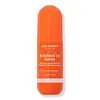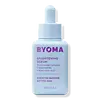What's inside
What's inside
 Key Ingredients
Key Ingredients

 Benefits
Benefits

 Concerns
Concerns

 Ingredients Side-by-side
Ingredients Side-by-side

Water
Skin ConditioningDimethicone
EmollientPropanediol
SolventGlycerin
HumectantGlycolic Acid
BufferingPolysilicone-11
Tetrahexyldecyl Ascorbate
AntioxidantPhenoxyethanol
PreservativeHydroxyethyl Acrylate/Sodium Acryloyldimethyl Taurate Copolymer
Emulsion StabilisingSodium Hydroxide
BufferingXanthan Gum
EmulsifyingButylene Glycol
HumectantAllantoin
Skin ConditioningPolyacrylate Crosspolymer-6
Emulsion StabilisingEthylhexylglycerin
Skin ConditioningSorbitan Isostearate
EmulsifyingTetrasodium Glutamate Diacetate
Decyl Glucoside
CleansingCaprylyl Glycol
EmollientHexylene Glycol
EmulsifyingT-Butyl Alcohol
PerfumingLactobacillus Ferment Lysate
Skin ConditioningTin Oxide
AbrasiveLaminaria Digitata Extract
Skin ProtectingSpirulina Platensis Extract
Skin ProtectingUlva Lactuca Extract
Skin ConditioningPhytic Acid
Mica
Cosmetic ColorantCI 77891
Cosmetic ColorantIron Oxides
Water, Dimethicone, Propanediol, Glycerin, Glycolic Acid, Polysilicone-11, Tetrahexyldecyl Ascorbate, Phenoxyethanol, Hydroxyethyl Acrylate/Sodium Acryloyldimethyl Taurate Copolymer, Sodium Hydroxide, Xanthan Gum, Butylene Glycol, Allantoin, Polyacrylate Crosspolymer-6, Ethylhexylglycerin, Sorbitan Isostearate, Tetrasodium Glutamate Diacetate, Decyl Glucoside, Caprylyl Glycol, Hexylene Glycol, T-Butyl Alcohol, Lactobacillus Ferment Lysate, Tin Oxide, Laminaria Digitata Extract, Spirulina Platensis Extract, Ulva Lactuca Extract, Phytic Acid, Mica, CI 77891, Iron Oxides
Water
Skin ConditioningMethylpropanediol
SolventNiacinamide
Smoothing1,2-Hexanediol
Skin ConditioningGlycerin
HumectantPolyglyceryl-10 Laurate
Skin ConditioningSodium Hyaluronate
HumectantCeramide NP
Skin ConditioningCholesterol
EmollientCaprylic/Capric Triglyceride
MaskingPhytosphingosine
Skin ConditioningSodium Phytate
Ascorbic Acid
AntioxidantStearic Acid
CleansingOleic Acid
EmollientHydrogenated Lecithin
EmulsifyingEthylhexylglycerin
Skin ConditioningXanthan Gum
EmulsifyingSqualane
EmollientTocopherol
AntioxidantLactic Acid
BufferingCarbomer
Emulsion StabilisingTromethamine
BufferingCaprylyl Glycol
EmollientCaprylhydroxamic Acid
Water, Methylpropanediol, Niacinamide, 1,2-Hexanediol, Glycerin, Polyglyceryl-10 Laurate, Sodium Hyaluronate, Ceramide NP, Cholesterol, Caprylic/Capric Triglyceride, Phytosphingosine, Sodium Phytate, Ascorbic Acid, Stearic Acid, Oleic Acid, Hydrogenated Lecithin, Ethylhexylglycerin, Xanthan Gum, Squalane, Tocopherol, Lactic Acid, Carbomer, Tromethamine, Caprylyl Glycol, Caprylhydroxamic Acid
 Reviews
Reviews

Ingredients Explained
These ingredients are found in both products.
Ingredients higher up in an ingredient list are typically present in a larger amount.
Caprylyl Glycol is a humectant and emollient, meaning it attracts and preserves moisture.
It is a common ingredient in many products, especially those designed to hydrate skin. The primary benefits are retaining moisture, skin softening, and promoting a healthy skin barrier.
Though Caprylyl Glycol is an alcohol derived from fatty acids, it is not the kind that can dry out skin.
This ingredient is also used as a preservative to extend the life of products. It has slight antimicrobial properties.
Learn more about Caprylyl GlycolEthylhexylglycerin (we can't pronounce this either) is commonly used as a preservative and skin softener. It is derived from glyceryl.
You might see Ethylhexylglycerin often paired with other preservatives such as phenoxyethanol. Ethylhexylglycerin has been found to increase the effectiveness of these other preservatives.
Glycerin is already naturally found in your skin. It helps moisturize and protect your skin.
A study from 2016 found glycerin to be more effective as a humectant than AHAs and hyaluronic acid.
As a humectant, it helps the skin stay hydrated by pulling moisture to your skin. The low molecular weight of glycerin allows it to pull moisture into the deeper layers of your skin.
Hydrated skin improves your skin barrier; Your skin barrier helps protect against irritants and bacteria.
Glycerin has also been found to have antimicrobial and antiviral properties. Due to these properties, glycerin is often used in wound and burn treatments.
In cosmetics, glycerin is usually derived from plants such as soybean or palm. However, it can also be sourced from animals, such as tallow or animal fat.
This ingredient is organic, colorless, odorless, and non-toxic.
Glycerin is the name for this ingredient in American English. British English uses Glycerol/Glycerine.
Learn more about GlycerinWater. It's the most common cosmetic ingredient of all. You'll usually see it at the top of ingredient lists, meaning that it makes up the largest part of the product.
So why is it so popular? Water most often acts as a solvent - this means that it helps dissolve other ingredients into the formulation.
You'll also recognize water as that liquid we all need to stay alive. If you see this, drink a glass of water. Stay hydrated!
Learn more about WaterXanthan gum is used as a stabilizer and thickener within cosmetic products. It helps give products a sticky, thick feeling - preventing them from being too runny.
On the technical side of things, xanthan gum is a polysaccharide - a combination consisting of multiple sugar molecules bonded together.
Xanthan gum is a pretty common and great ingredient. It is a natural, non-toxic, non-irritating ingredient that is also commonly used in food products.
Learn more about Xanthan Gum